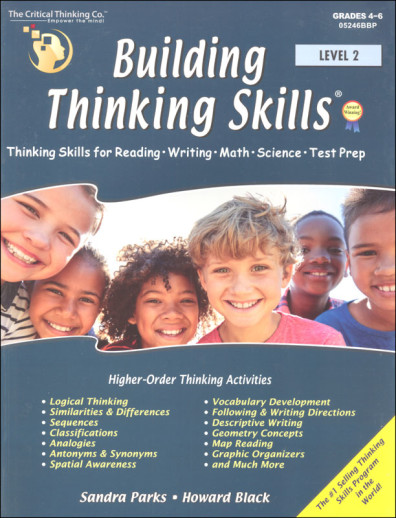We use cookies to make your experience better. To comply with the new e-Privacy directive, we need to ask for your consent to set the cookies. Learn more.
Building Thinking Skills Level 2
Recently updated with new or reorganized activities and updated colorful graphics, Building Thinking Skills Level 2 retains its effective, comprehensive coverage of verbal and nonverbal reasoning skills. Lessons cover describing and comparing shapes and figures, diagrams (including Venn), mental patterns/symmetry, directionality, analogies, visual motor integration and memory, graphic organizers, verbal skills, spelling/vocabulary/writing, deductive/inductive reasoning, map reading, logic, and much more. Visually appealing activities are sequenced developmentally and build from semi-concrete to abstract verbal forms. By design, the activities will challenge students, and some teaching support may be necessary. Parents/Teachers and students will appreciate the engaging nature of the activities, even through the challenges! New editions are not compatible with the previous edition. Answers included in the back of the book. Reproducible for family or single classroom use. ~Deanne
This engaging 412-page book develops the critical thinking skills necessary for success in reading, writing, math, science, social studies, and standardized tests in Grades 4-6. The Building Thinking Skills® series is the bestselling thinking skills program in the world! The engaging, highly-effective activities are developmentally sequenced. Each skill (for example, classifying) is presented first in the semi-concrete, figural-spatial form. Students also learn important academic vocabulary, concepts, and skills as they analyze relationships between objects, between words, and between objects and words by: Observing, recognizing, and describing characteristics; Distinguishing similarities and differences; and Identifying and completing sequences, classifications, and analogies.
This is a very complete thinking skills program, covering all of the figural and verbal skills your children are likely to see on a standardized test. The publisher, Critical Thinking Press, states that Building Thinking Skills is "designed to significantly improve verbal and figural skills in four important areas: similarities and differences, sequences, classifications, and analogies. Proficiency in these skills is the cornerstone of success in all academic areas, on standardized tests, and on college entrance exams." They have scads of testimonials documenting the correlation between use of this series and increased test scores. We have no doubt that all the practice you get in using this series would, indeed, improve test scores. More importantly, many of the specific skills practiced here also have application in different professions. Other skills would seem to generally improve your ability to "see things" in different ways or train your mind to stretch in different directions.
The broader goals of this series are translated into specific skills and exercises within these areas. Learning is spiral within skills, within books, and between levels. That is, exercises progress in sophistication and scope within each book, and from level to level. This translates into several hefty worktexts full of practice exercises that children actually enjoy doing! Except for the Primary level, students can work pretty much on their own, proceeding as quickly through the series as they're able. If you're starting an older child in the series, however, use the suggested grade levels for proper placement.
May be used earlier if student has completed Book 1. All skills learned in Book 1 are reviewed and exercises become increasingly complex with more specific skills. Examples of skills practiced are classification, following directions, deductive reasoning, parts of a whole, Word Benders, Venn and branching diagrams, pattern folding, rotation, reflection, overlapping classes and mental manipulation of two-dimensional objects. Answers included, 408 pgs. Revised in 2006.
An optional Teacher CD is also available. It contains the full text of the Teacher's Edition in PDF format. Although answers are already included in the worktext, the Teacher CD also features objectives, focus questions and additional background information for the teacher.
The software version of the program features the same activities as the worktexts, but in an interactive format. There are 10 levels of activities which can be played in either "mission" or "practice" mode. Approximately 40 activities are included in the software, with over 800 questions in all. Instructions are both spoken and written. System requirements: Windows 98/NT/Me/2000/XP/Vista or Mac OS X (10.3+), PowerPC. 128 MB RAM for either.
| Product Format: | Paperback |
|---|---|
| Brand: | Critical Thinking Company |
| Grades: | 4-7 |
| ISBN: | 9781601449924 |
| Length in Inches: | 11 |
| Width in Inches: | 8.5 |
| Height in Inches: | 1.125 |
| Weight in Pounds: | 2.8 |

